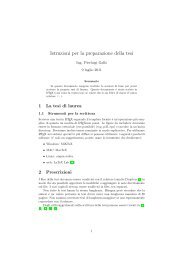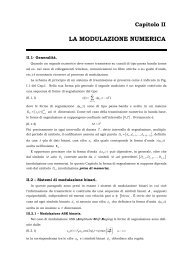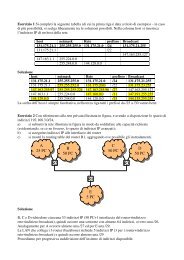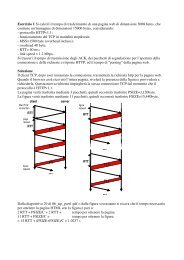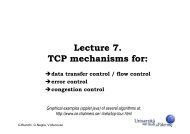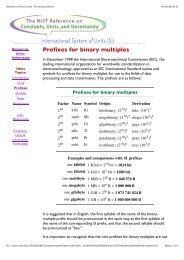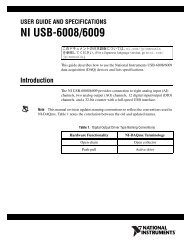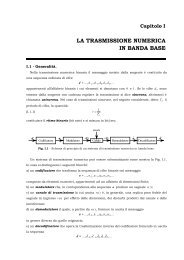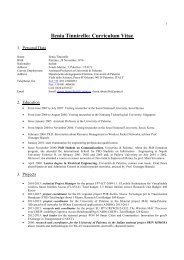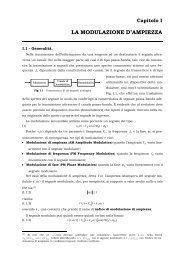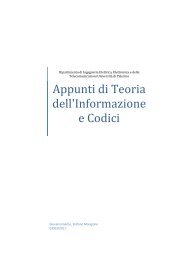Il dominio della frequenza
Il dominio della frequenza
Il dominio della frequenza
You also want an ePaper? Increase the reach of your titles
YUMPU automatically turns print PDFs into web optimized ePapers that Google loves.
Cap. II – Rappresentazione dei segnali nel <strong>dominio</strong> <strong>della</strong> <strong>frequenza</strong> - 23-<br />
(II.3.10) st () dt< ∞<br />
poiché è:<br />
(II.3.11)<br />
∫<br />
∞<br />
−∞<br />
∞<br />
−j2πft<br />
∞<br />
∫−∞<br />
∫<br />
∞<br />
−∞<br />
S( f) = s() t e dt ≤ s()<br />
t dt <<br />
il limite (II.3.9) può essere effettuato come segue:<br />
(II.3.12)<br />
T<br />
2 −j2πft<br />
lim S( f) − s( t) e dt 0<br />
−T<br />
→∞<br />
∫<br />
=<br />
2<br />
T<br />
2<br />
T<br />
che equivale a dire che la convergenza dell’integrale ∫ s(t)e − j2πn Tdt<br />
t è uniforme.<br />
Considerazioni analoghe valgono per l’antitrasformata di Fourier.<br />
La trasformata e l’antitrasformata di Fourier, nel contesto, vengono a volte indicate come<br />
segue:<br />
− j2<br />
(II.3.13) { }<br />
−<br />
(II.3.14) F { }<br />
− T 2<br />
πft<br />
S( f) = F st () =<br />
∫<br />
ste () dt<br />
−∞<br />
1 ∞<br />
( ) ( ) ( ) j2<br />
π ft<br />
s t = S f =<br />
∫<br />
S f e<br />
−∞<br />
la trasformata di Fourier di un segnale è, in generale una funzione complessa. Essa pertanto<br />
può essere rappresentata in una delle due forme seguenti:<br />
j ( f )<br />
(II.3.15)<br />
S( f) = S ( f) + jS ( f) = S( f)<br />
e ϑ<br />
R<br />
I<br />
I diagrammi che riportano gli andamenti di S( f ) e ϑ( f ) in funzione <strong>della</strong> <strong>frequenza</strong> prendono<br />
il nome di spettri di ampiezza e di fase del segnale s(t) .<br />
∞<br />
df<br />
Esempio E.II.2<br />
• Impulso rettangolare.<br />
• Impulso esponenziale.<br />
T<br />
∞<br />
t<br />
t<br />
2<br />
{ (<br />
T)<br />
} ∫ (<br />
T) ∫ T<br />
−∞<br />
− j2πft − j2πft<br />
−<br />
F rect = rect e dt = e dt = Tsinc( fT)<br />
t<br />
t<br />
1<br />
− ∞ − 2<br />
( 2<br />
T T<br />
− π<br />
∞ − + πf T<br />
) t<br />
{ () } ()<br />
∫<br />
2<br />
j ft T<br />
∫0<br />
F ute = ute e dt= e dt= −∞<br />
1 + j2<br />
π fT<br />
• Impulso cisoidale tempo limitato.<br />
t<br />
1<br />
t j2 2 2 ( )<br />
{ ( ) } π T<br />
j f t<br />
T<br />
T<br />
∫<br />
π −<br />
T<br />
F rect e = e dt = T sinc(1 − fT)<br />
T<br />
−<br />
2<br />
II.4 – Proprietà <strong>della</strong> trasformata di Fourier.<br />
In quel che segue sono dedotte talune fondamentali proprietà <strong>della</strong> trasforma di Fourer di<br />
un segnale.<br />
• Proprietà 1. Segnali reali.<br />
Se s(t) è reale dalla condizione s() t = s*()<br />
t discende;<br />
*<br />
2 2 2<br />
(II.4.1)<br />
∞ j πft j ft j ft j ft<br />
S( f) e df<br />
⎛<br />
∞ π<br />
S( f) e dt<br />
⎞<br />
∞ − π<br />
S*( f) e df ∞<br />
2π<br />
∫<br />
= ⎜<br />
⎟ = = S*( −f)<br />
e df<br />
−∞ ⎝∫−∞ ⎠<br />
∫−∞ ∫−∞<br />
dove si è operata la trasformazione f<br />
→− f<br />
(II.4.2) S( f) = S*( − f)<br />
. Dalla precedente si deduce<br />
che comporta che<br />
(II.4.3)<br />
S( − f) = S( f)<br />
ϑ− ( f ) =−ϑ(<br />
f )



